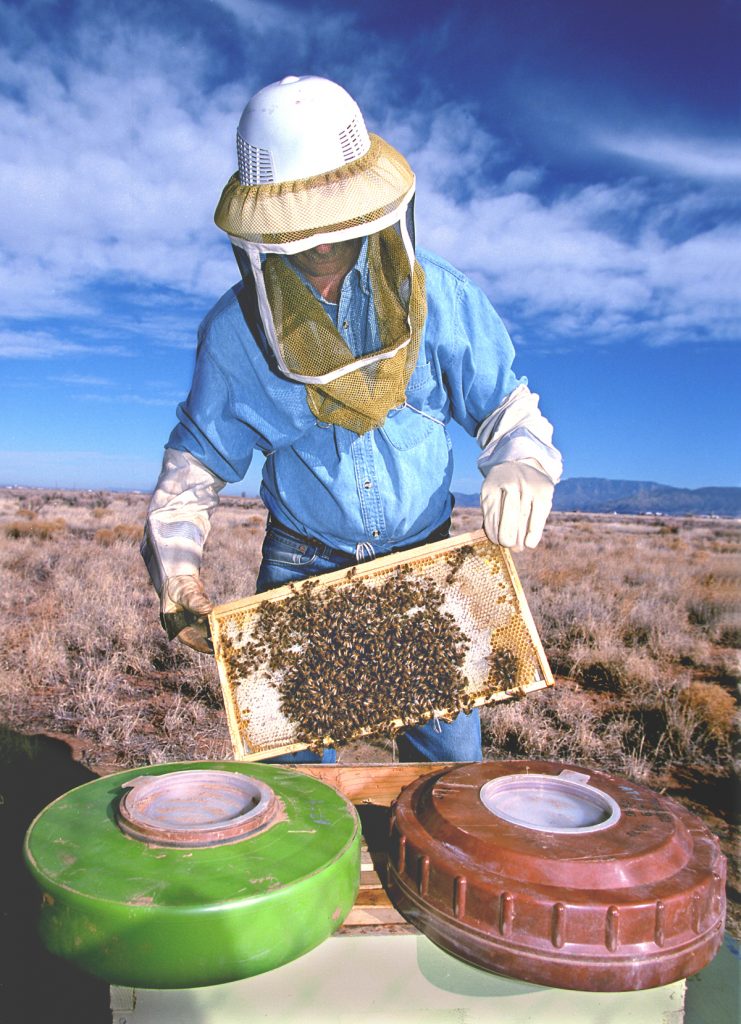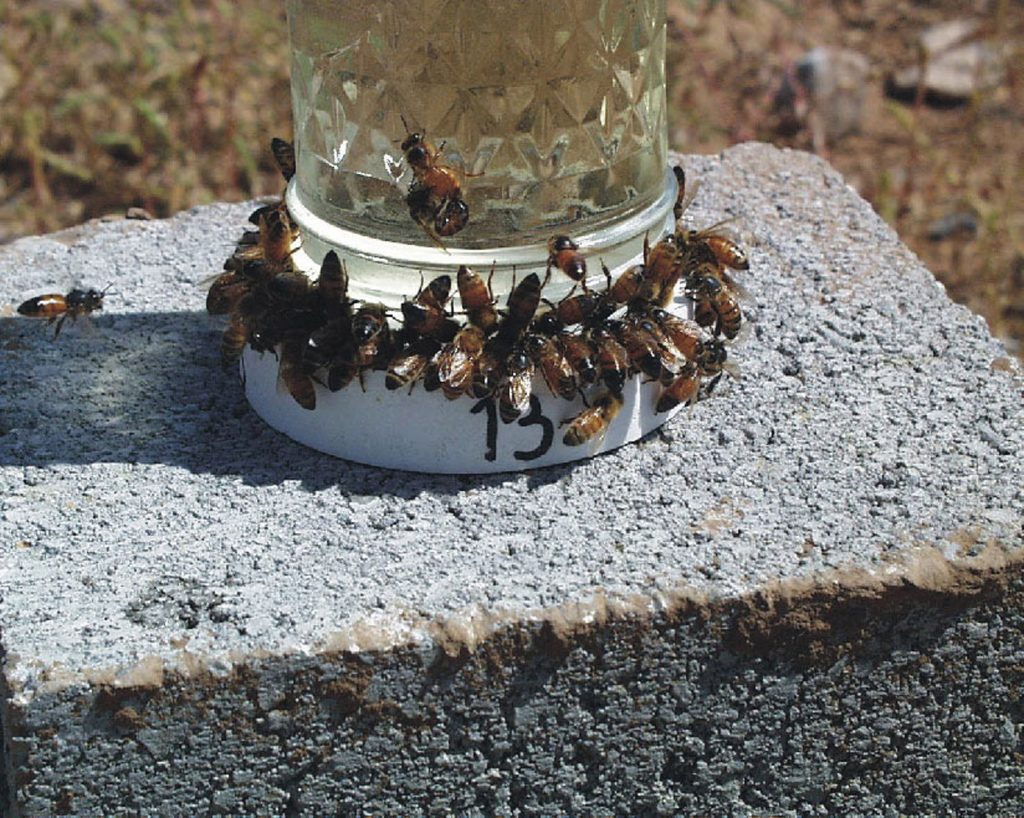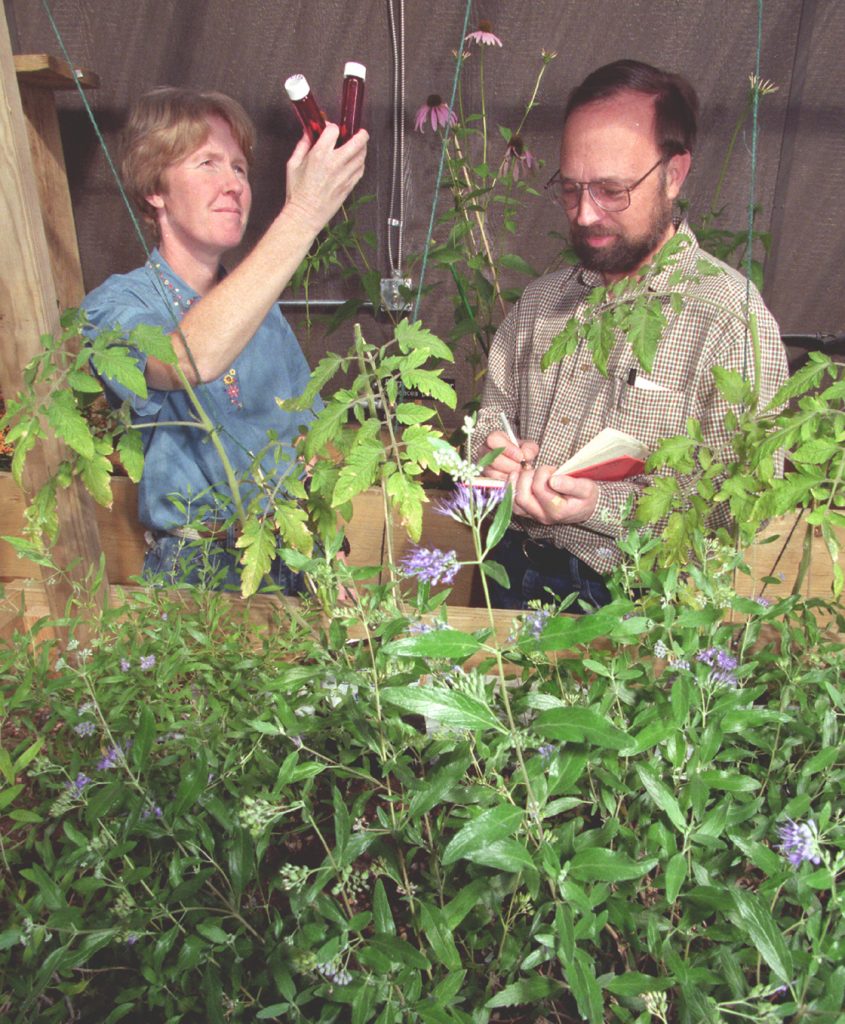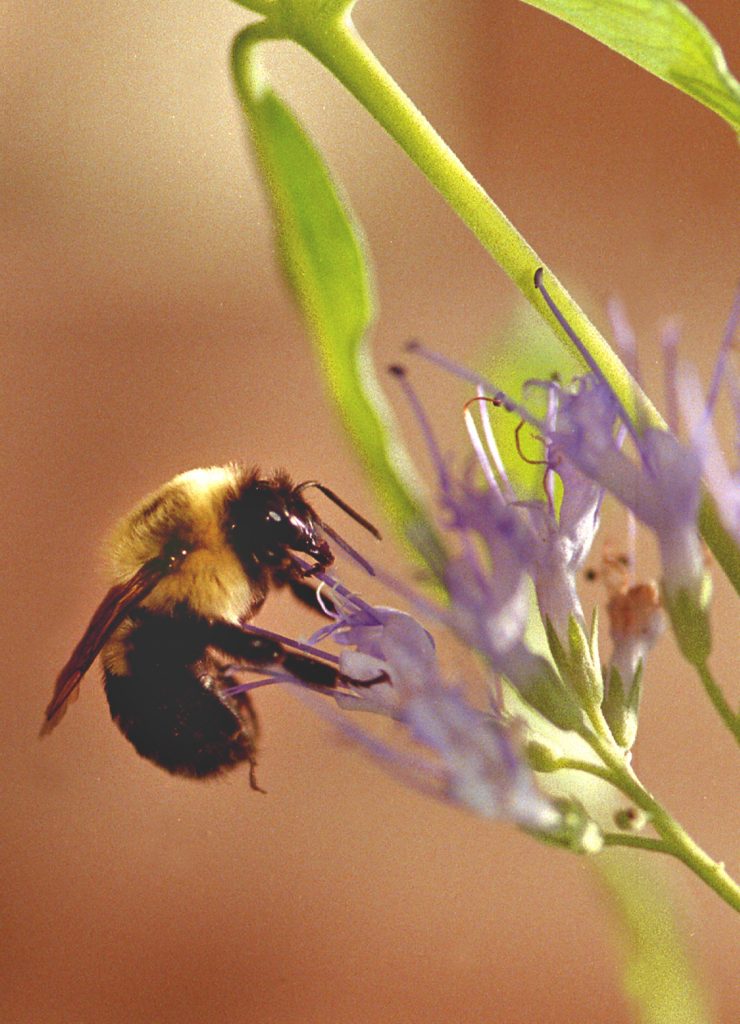
Download 300dpi JPEG image, ‘BeeMine.jpg’, 2.3Mb (Media are welcome to download/publish this image with related news stories.)
ALBUQUERQUE, N.M. — Bees dutifully going about their daily business — gathering nectar and pollen and taking it back to the hive — may one day help protect the lives and limbs of people, literally, if a landmine-detection demonstration at the Department of Energy’s Sandia National Laboratories is successful.
Sandia chemists are working with entomologists at the University of Montana to see if foraging bees can reliably and inexpensively detect buried mines and safely return hundreds of thousands of acres of uncharted land back to productive use. The work is funded by the Defense Advanced Research Projects Agency’s (DARPA) Controlled Biological Systems Program.
Landmines have been called the worst form of pollution on earth. Some 60 people are maimed or killed by buried mines every day. The Red Cross estimates that 80-120 million landmines currently are deployed in 70 countries worldwide, with an average 40,000 new landmines deployed each week.
In many developing countries, thousands of acres of land lie unused because farmers are afraid to work their fields. Streams and other sources of water are littered with mines. In some countries professional mine prodders are paid a few dollars a day to carefully poke the soil every few inches with a metal probe checking for buried mines.
‘Flying dust mops’
In the bee demonstration, Sandia is working with Jerry Bromenshenk at the University of Montana — Missoula to see if bees can be trained to find residues of TNT, the primary ingredient of most landmines, and bring the evidence home.

Download 300dpi JPEG image, ‘bees.jpg’, 1.4MB (Media are welcome to download/publish this image with related news stories.)
The project builds on three decades of explosives-detection work at Sandia and 25 years of biosystems research at the University of Montana.
Bromenshenk and his colleagues have shown that as bees forage for nectar and pollen, they attract particles of dust, soil, and pollen to their fuzzy, statically charged bodies and bring samples back to the hive. In doing so they provide a chemical survey of an area extending a mile or more from the hive in all directions.
“Bees are like flying dust mops,” says Bromenshenk. “Wherever they go, they pick up dust, airborne chemicals, and other samples. If it’s out there, they’ll find it and bring it back.”
All landmines leak small amounts of explosives into nearby soil or water. Sandia’s mine-detection research has focused on predicting what happens to mine-leaked vapors and residues and their chemical byproducts in the environment as they are adsorbed on soil particles, permeated or leached through soil, dissolved in water, and consumed by animals and plants. By modeling the “fate and transport” of explosives and understanding where they concentrate in the environment, the researchers are better able to detect their presence at lower levels and determine optimum conditions for detection.
Based on this work, Sandia is developing a number of mine-detection systems, including handheld chemical “sniffers,” soil-penetrating vapor extractors, and methods to enhance the chemical signature of landmines. Many of these systems can detect plastic landmines, which most conventional metal-detector-based systems cannot.

Download 300dpi JPEG image, ‘SusanBee.jpg’, 2M (Media are welcome to download/publish this image with related news stories.)
Increasing bees’ odds
The bee demonstration in Albuquerque makes use of a remote test area laden with mock mines, specifically built for Sandia’s landmine-detection research. Last fall the Sandia team established two small honeybee hives in the landmine field. They also established two control hives a few miles away, from which they’ll gather baseline data.
Several varieties of plants are being grown in an enclosed greenhouse near the test site. The plants’ soil is tainted with varying levels of TNT so the researchers can study how efficiently the plants uptake the TNT.
“There is very little written in the scientific literature about plant uptake of explosive contaminants,” says Sandia’s Susan Bender. “We are conducting new studies to see if plants rooted in TNT-tainted soil will uptake the residues into their roots, stems, and flowers, and even incorporate them into their pollens.”
If plants that readily accumulated the TNT could be identified, a suspected minefield could be seeded with those plants (by air) to maximize the bees’ chances of finding the mines.
Inside the greenhouse a small colony of bumblebees has been established to measure how efficiently the bees carry TNT-tainted pollen and soil back to the hive.
“The greenhouse, plant uptake experiments, and control hives are designed to increase our chances of success when we begin testing the bees in the landmine field,” says Sandia explosives chemist Phil Rodacy. “We’ll compare the results we get in the controlled environments with the results we get in the field to see how well the bees are doing.”

Download 300dpi JPEG image, ‘BombBee.jpg’, 2.1M (Media are welcome to download/publish this image with related news stories.)
Tracking bees’ behaviors
Later this spring Bromenshenk and a team of colleagues and students plan to come to work at Sandia. New colonies of honeybees will be introduced at the test minefield.
The Montana team will use highly instrumented “honeybee condos,” which automatically count the number of times bees fly in and out of the hive, to track the bees’ flight activity.
Bromenshenk’s team has shown that subtle changes in flight activity and other bee behaviors can signal that the bees are being exposed to environmental contaminants.
Pollen, dust, air, and other samples collected by the bees and brought to the hive will be analyzed for trace amounts of explosives. Sandia will examine the samples using highly sensitive chemical analysis tools to determine whether the bees can reliably indicate the presence of landmines in an area over time.
One goal of ongoing tests at Montana is to determine which explosives bees can smell and then train them to seek those chemicals. If bees can be trained to associate the odor of explosives (such as TNT) with food (sugar syrup, for instance), says Bromenshenk, the bees may spend more time near plants and surface soils contaminated with TNT, increasing the odds that they would bring back TNT residues from an area that contains buried mines.
Bromenshenk has demonstrated that by providing a new bee colony with feeders tainted with a marker chemical, then gradually moving the feeders farther from the hive and eventually removing them, bees can be trained to forage wherever they smell the chemical. If bees can be trained to seek TNT, the Montana team may attach small diodes onto the backs of several hundred TNT-trained bees. Then, using a handheld radar tracking device, they will chart where those bees go to determine whether they tend to forage near the locations of known landmines.
Countering the worst form of pollution on earth
The ultimate goal of the project, says Bender, is to determine whether buried mines are present in large areas by establishing beehives near the suspected mines, monitoring bees’ flight activity, and analyzing hive samples.
“If this method works and it’s reliable, you could foresee giving people the green light to re-enter or farm large areas based on bee sampling,” she says.
DARPA’s Controlled Biological Systems Program supports research of sentinel species (such as bees, wasps, caterpillars, and moths), biohybrids (robotic systems that make use of animal features), and robotic systems for detection of contaminants and other environmental variables.
“The beauty of this approach is that bees are indigenous to every climate on earth, and there are beekeepers everywhere,” Bender says. “And you wouldn’t need a million-dollar piece of equipment and extensive training to use it. The countries where landmines are a problem typically don’t have those kinds of resources.”